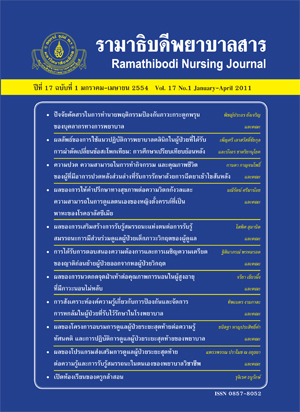ความปวด ความสามารถในการทำกิจกรรม และคุณภาพ วิตของผู้ที่มีอาการ ปวดหลังส่วนล่างที่รับการรักษาด้วยการฉีดยาเข้าไขสันหลัง
Main Article Content
Abstract
บทคัดย่อ
การวิจัยครั้งนี้มีวัตถุประสงค์เพื่อศึกษาความปวด ความสามารถในการทำกิจกรรมและคุณภาพชีวิตก่อนและหลังการฉีดยาเข้าไขสันหลังในผู้ที่มีอาการปวดหลังส่วนล่าง โดยใช้แนวคิดคุณภาพชีวิตขององค์การอนามัยโลก กลุ่มตัวอย่างเป็นผู้ป่วยอาการปวดหลังส่วนล่างที่มารับการรักษาที่แผนกตรวจผู้ป่วยนอกออร์โธปิดิกส์ โรงพยาบาลรามาธิบดี เลือกกลุ่มตัวอย่างแบบเฉพาะเจาะจง ตามเกณฑ์คุณสมบัติที่กำหนด จำนวน 80 ราย เก็บข้อมูลระหว่าง เดือนเมษายน ถึงเดือนสิงหาคม 2552 โดยใช้ Numeric Rating Scale วัดความปวด วัดความสามารถในการทำกิจกรรมโดยใช้ Modified Oswestry Low Back Pain Disability Questionnaire และใช้แบบวัดคุณภาพชีวิตขององค์การอนามัยโลก ฉบับภาษาไทย นำเสนอข้อมูลโดยการแจกแจงความถี่ ร้อยละ ค่าเฉลี่ย ส่วนเบี่ยงเบนมาตรฐาน และวิเคราะห์ข้อมูลโดยใช้ สถิติ one factor repeated measuresANOVA และ McNemar’s test ผลการศึกษา พบว่า หลังการฉีดยาเข้าไขสันหลัง (epiduralsteroid injection: ESI) 1 และ 4 สัปดาห์กลุ่มตัวอย่างมีความปวดลดลง ความสามารถในการทำกิจกรรมสูงขึ้นกว่าก่อนฉีดยาอย่างมีนัยสำคัญทางสถิติ คุณภาพชีวิตหลังฉีดยา 1 สัปดาห์สูงขึ้นกว่าก่อนฉีดยาอย่างมีนัยสำคัญทางสถิติ แสดงให้เห็นถึงผลของการฉีดยาในการรักษาอาการปวดหลังส่วนล่าง ข้อมูลที่ได้สามารถนำไปใช้เป็นข้อมูลพื้นฐานในการให้คำแนะนำแก่ผู้ป่วยในการดูแลสุขภาพ ในการเลือกแนวทางในการรักษาอาการปวดหลังส่วนล่าง และนำไปใช้เป็นแนวทางในการพัฒนาแนวปฏิบัติทางการพยาบาลเกี่ยวกับการเตรียมผู้ป่วยก่อนเข้ารับการฉีดยาเข้าไขสันหลัง เพื่อให้ผู้ป่วยเข้าใจและปฏิบัติตนได้ถูกต้องทั้งก่อนและหลังการฉีด
คำสำคัญ : อาการปวดหลังส่วนล่างว, ความสามารถในการทำกิจกรรม, คุณภาพชีวิต, การฉีดยาเข้าไขสันหลัง
Abstract
The purpose of this research was to describe and compare pain, functionalability, and quality of life before and after epidural steroid injection (ESI) in personswith low back pain. The subjects included 80 patients with low back pain at theOrthopaedics Outpatient Department, Ramathibodi Hospital, Bangkok. They wereselected by purposive sampling. Data were collected from April to August 2009. Theinstruments used included the Numeric Rating Scale to measure pain score, the ModifiedOswestry Low Back Pain Disability Questionnaire (Modified ODQ) to measure thefunctional ability, and the WHOQOL-BRIEF–THAI to measure quality of life. Datawere analyzed in terms of descriptive statistics, inferential statistics including onefactor repeated measure ANOVA, and McNemar’s test. Findings of this study showedthat after epidural steroid injection (ESI) at one and four weeks, the subjects’ painscores significantly decreased. In addition, the subjects’ functional ability after ESIwas significantly higher than that before ESI. The quality of life of the subjects alsosignificantly increased after ESI. Findings of the study revealed the effect of ESI onpain reduction, functional ability improvement, and promotion of quality of life inpersons with low back pain, and provided useful data to guide healthcare service ofpatients with low back pain. Finally, the data can be used to prepare a nursing guidelinefor patients who require treatment of low back pain by ESI. The guideline can helppatients to appropriately self care before and after ESI.
Keywords : Low back pain, Functional ability, Quality of life, Epidural steroid injection
Article Details
บทความ ข้อมูล เนื้อหา รูปภาพ ฯลฯ ที่ได้รับการตีพิมพ์ในรามาธิบดีพยาบาลสาร ถือเป็นลิขสิทธิ์ของวารสาร หากบุคคลหรือหน่วยงานใดต้องการนำทั้งหมดหรือส่วนหนึ่งส่วนใดไปเผยแพร่หรือเพื่อกระทำการใด ใด จะต้องได้รับอนุญาตเป็นลายลักษณ์อักษรจากรามาธิบดีพยาบาลสารก่อนเท่านั้น


